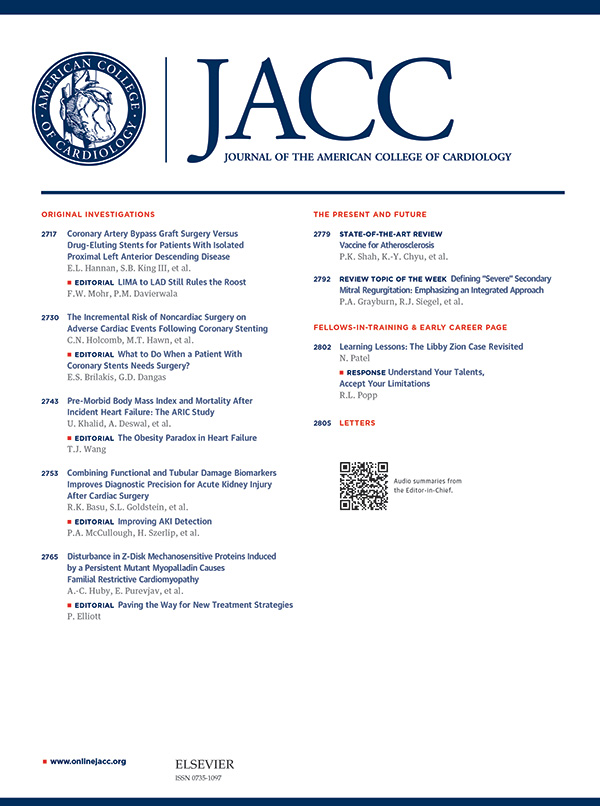Sodium Zirconium Cyclosilicate for Management of Hyperkalemia During Spironolactone Optimization in Patients with Heart Failure
IF 21.7
1区 医学
Q1 CARDIAC & CARDIOVASCULAR SYSTEMS
引用次数: 0
Abstract
Background
Mineralocorticoid receptor antagonists (MRA) improve outcomes in patients with heart failure and reduced ejection fraction (HFrEF) but are underused in clinical practice. Observational data suggest that hyperkalemia is the leading obstacle for the suboptimal use of MRA.Objectives
We evaluated the effects of sodium zirconium cyclosilicate (SZC) in optimizing use of spironolactone among participants with HFrEF and hyperkalemia.Methods
REALIZE-K (NCT04676646) was a prospective, double-blind, randomized- withdrawal trial in participants with HFrEF (NYHA II–IV; left ventricular ejection fraction ≤40%), optimal guideline-directed therapy (except MRA), and prevalent or incident MRA- induced hyperkalemia. During open-label run-in, participants underwent spironolactone titration (target: 50 mg/daily); those with hyperkalemia started SZC. Participants with normokalemia (potassium 3.5–5.0 mEq/L) on SZC and spironolactone ≥25 mg/daily were randomized to continued SZC or placebo for 6 months. The primary endpoint was optimal treatment response (normokalemia on spironolactone ≥25 mg/daily without rescue therapy for hyperkalemia [months 1–6]). The five key secondary endpoints were tested hierarchically. Exploratory endpoints included a composite of adjudicated cardiovascular death or worsening HF events (hospitalizations and urgent visits).Results
Overall, 203 participants were randomized (SZC 102, placebo 101). Higher percentage of SZC- versus placebo-treated participants had optimal response (71% vs 36%; OR 4.45 [95% CI 2.89–6.86]; p<0.001). SZC (versus placebo) improved the first four key secondary endpoints: normokalemia on randomization dose of spironolactone and without rescue therapy (58% vs 23%; OR 4.58 [2.78–7.55]; p<0.001), receiving spironolactone ≥25 mg/daily (81% vs 50%; OR 4.33 [2.50–7.52]; p<0.001), time to hyperkalemia (HR 0.51 [0.37–0.71]; p<0.001), time to decrease/discontinuation of spironolactone due to hyperkalemia (HR 0.37 [0.17–0.73]; p=0.006). There was no between-group difference in KCCQ-CSS at 6 months (-1.01 points [-6.64–4.63]; p=0.72). Adverse events (64% vs 63%) and serious adverse events (23% vs 22%) were balanced between SZC and placebo, respectively. Composite of CV death or worsening HF occurred in 11 (11%) participants in the SZC group (1 with CV death, 10 with HF events) and 3 (3%) participants in the placebo group (1 with CV death, 2 with HF events; log-rank nominal p=0.034).Conclusions
In participants with HFrEF and hyperkalemia, SZC led to large improvements in the percentage of participants with normokalemia while on optimal spironolactone dose, and reduced risk of hyperkalaemia and down-titration/discontinuation of spironolactone.Although underpowered for clinical outcomes, more participants had HF events with SZC than placebo, which should be factored into the clinical decision making.环硅酸锆钠用于治疗心力衰竭患者螺内酯优化期间的高钾血症
背景矿物皮质激素受体拮抗剂(MRA)可改善射血分数降低型心力衰竭(HFrEF)患者的预后,但在临床实践中使用不足。目的 我们评估了环硅酸锆钠(SZC)在优化 HFrEF 和高钾血症患者使用螺内酯方面的效果。方法REALIZE-K(NCT04676646)是一项前瞻性、双盲、随机撤消试验,参加者均为高频低氧血症患者(NYHA II-IV;左心室射血分数≤40%),接受过最佳指南指导治疗(MRA除外),并存在或发生过由 MRA 引起的高钾血症。在开放标签试运行期间,参与者接受螺内酯滴定(目标值:50 毫克/天);出现高钾血症者开始服用 SZC。服用 SZC 且螺内酯≥25 毫克/天的正常血钾患者(血钾 3.5-5.0 mEq/L)被随机分配至继续服用 SZC 或安慰剂,为期 6 个月。主要终点是最佳治疗反应(服用螺内酯≥25 毫克/天后无高钾血症抢救治疗的正常血钾[第 1-6 个月])。对五个关键次要终点进行了分层测试。探索性终点包括判定的心血管死亡或HF恶化事件(住院和急诊)的复合终点。与安慰剂相比,SZC治疗参与者中获得最佳应答的比例更高(71% vs 36%;OR 4.45 [95% CI 2.89-6.86];p<0.001)。SZC(与安慰剂相比)改善了前四个关键次要终点:服用随机剂量螺内酯且未接受抢救治疗的正常血钾(58% vs 23%;OR 4.58 [2.78-7.55];p<0.001)、接受螺内酯≥25 mg/天(81% vs 50%;OR 4.33 [2.50-7.52];p<0.001)、高钾血症发生时间(HR 0.51 [0.37-0.71];p<0.001)、因高钾血症减少/停止使用螺内酯时间(HR 0.37 [0.17-0.73];p=0.006)。6个月时的KCCQ-CSS没有组间差异(-1.01分[-6.64-4.63];P=0.72)。SZC和安慰剂的不良事件发生率(64% vs 63%)和严重不良事件发生率(23% vs 22%)分别均衡。SZC组有11人(11%)发生冠心病死亡或HF恶化(1人发生冠心病死亡,10人发生HF事件),安慰剂组有3人(3%)发生冠心病死亡或HF恶化(1人发生冠心病死亡,2人发生HF事件;log-rank名义P=0.034)。结论 在患有高频低氧血症和高钾血症的参与者中,SZC可大幅提高在服用最佳螺内酯剂量时出现正常血钾的参与者比例,并降低高钾血症和螺内酯降量/停药的风险。虽然临床结果的馈源不足,但使用SZC发生高频事件的参与者多于使用安慰剂的参与者,临床决策时应考虑到这一点。
本文章由计算机程序翻译,如有差异,请以英文原文为准。
求助全文
约1分钟内获得全文
求助全文
来源期刊
CiteScore
42.70
自引率
3.30%
发文量
5097
审稿时长
2-4 weeks
期刊介绍:
The Journal of the American College of Cardiology (JACC) publishes peer-reviewed articles highlighting all aspects of cardiovascular disease, including original clinical studies, experimental investigations with clear clinical relevance, state-of-the-art papers and viewpoints.
Content Profile:
-Original Investigations
-JACC State-of-the-Art Reviews
-JACC Review Topics of the Week
-Guidelines & Clinical Documents
-JACC Guideline Comparisons
-JACC Scientific Expert Panels
-Cardiovascular Medicine & Society
-Editorial Comments (accompanying every Original Investigation)
-Research Letters
-Fellows-in-Training/Early Career Professional Pages
-Editor’s Pages from the Editor-in-Chief or other invited thought leaders

 求助内容:
求助内容: 应助结果提醒方式:
应助结果提醒方式:


